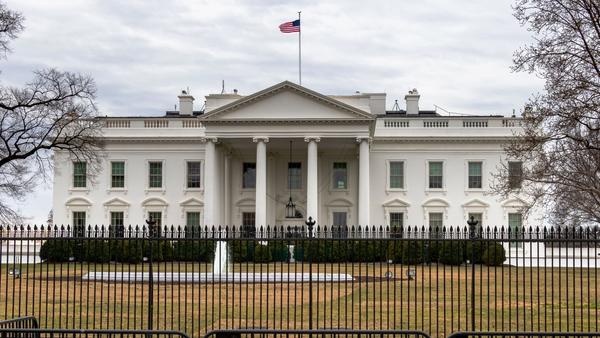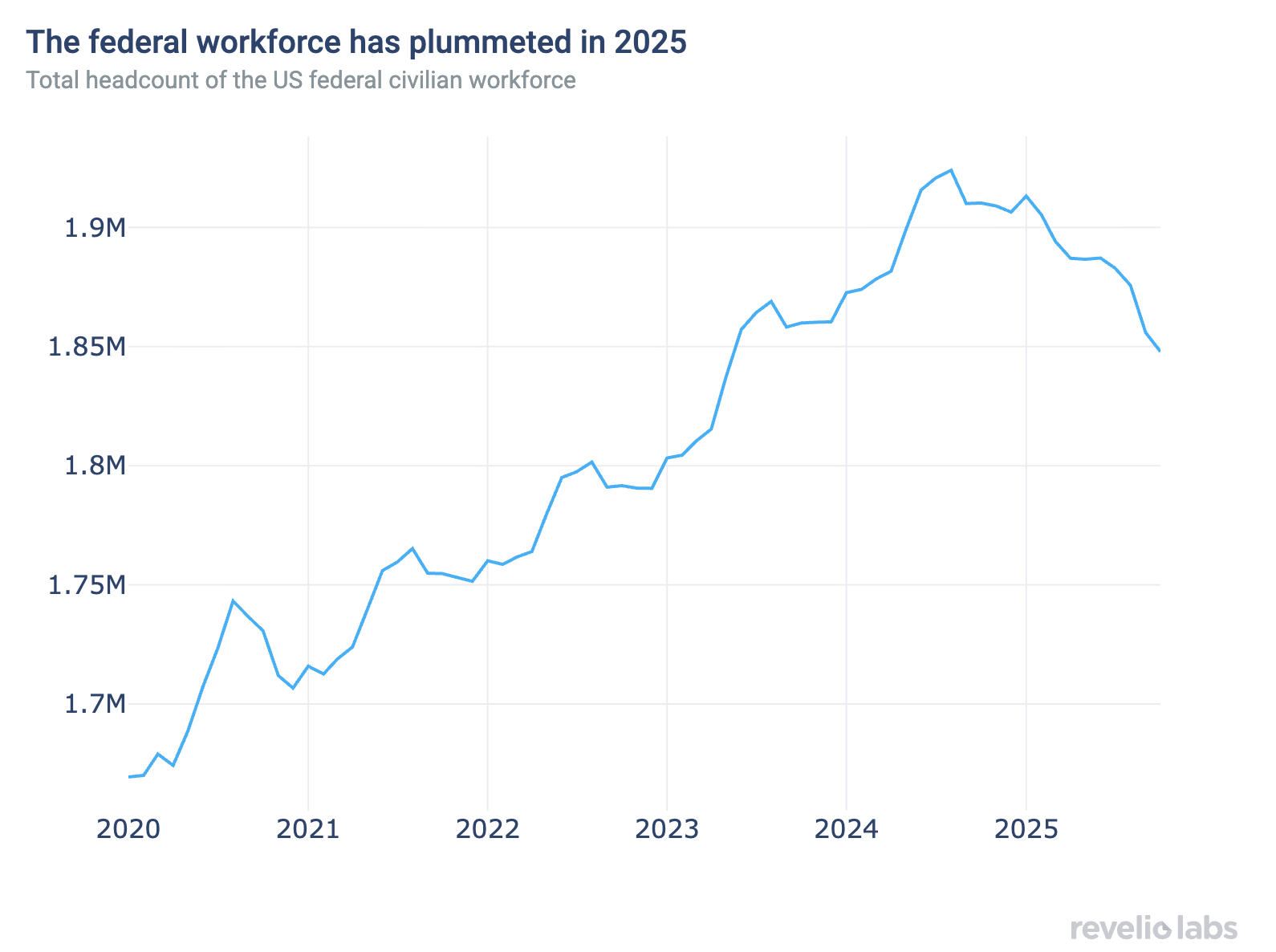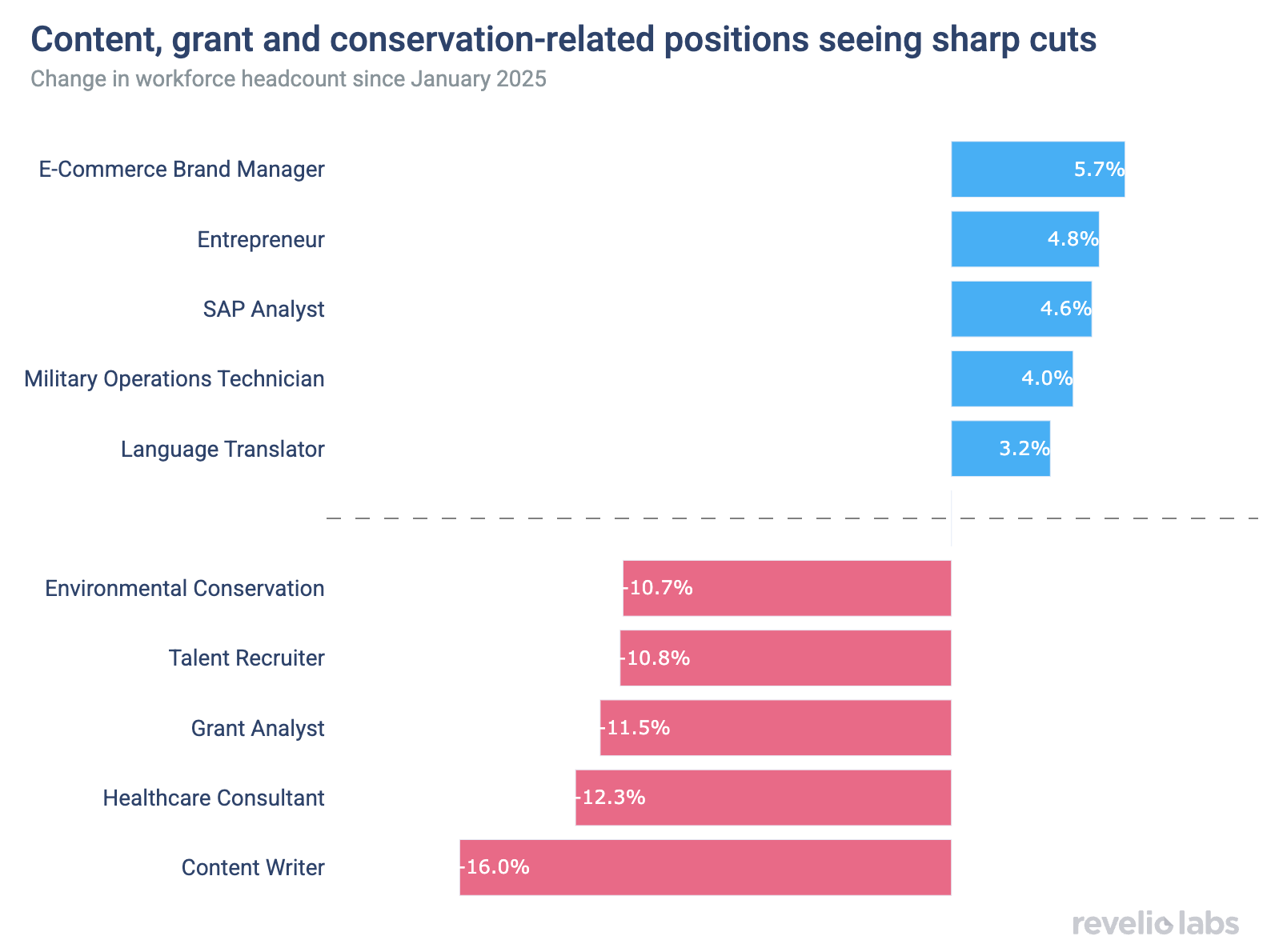The Trump Administration Is Reshaping the Federal Workforce
Policy priorities mean fewer regulators, more law enforcement

The Trump administration is reshaping the Federal workforce in line with its policy goals, with rapid contraction in agencies tied to regulation, international development, and environmental work.
Role-level data shows the steepest declines in sustainability, environmental conservation, and oversight functions, while growth is concentrated in training, health services, and positions related to energy infrastructure.
Job postings data indicates these trends are set to intensify, as recruitment has fallen sharply in 2025: Active postings have cratered for most positions while increasing primarily for law enforcement roles, highlighting a shift toward security and enforcement priorities.
The federal workforce is going through a historically tumultuous period. The second Trump administration has focused on reducing the size of the government: from DOGE to hiring freezes and full agency elimination. Programs like deferred resignation have made the full impact hard to determine in real time, but Revelio Labs’ data helps provide a clearer view of when and where the cuts are occurring. Our data also shows that this is not a one-way endeavour; the federal government is expanding in certain areas, as the Trump administration aims to reshape the workforce to match policy priorities.
In recent months the scale of the reduction in the federal workforce is being revealed, as deferred resignees permanently cut ties with the government. Since January 2025, Revelio Labs data indicates that federal employment has fallen nearly 4%. This contraction represents one of the largest overhauls of the federal workforce ever, affecting most major agencies and departments.


Agency-level data shows a clear pattern in line with the administration’s stated policy priorities. The fastest growing organizations in 2025 are concentrated in energy infrastructure and agriculture, such as Oak Ridge National Laboratory and the Farm Credit Administration. On the other side, the steepest declines in workforce occurred in agencies tied to regulation, global affairs, and independent oversight: Agencies that have long been under the ire of the administration, like USAID, Voice of America, and the Consumer Financial Protection Bureau.This divergence highlights the intentional reshaping of government capacity, with resources flowing toward domestic production and energy development, and away from international engagement and regulatory enforcement.
Notably, the Executive Office of the President is also on the list, with a decline of 21% in the workforce since the start of the year. The White House itself is doing more with less, as it has hired far fewer staff compared to previous administrations, including key personnel like Marco Rubio are simultaneously the Secretary of State, and head of USAID and the National Archives and Records Administration.


Role-level analysis further reveals this structural shift. Some of the biggest declines are concentrated in jobs tied to media, grants, tax, and environmental conservation. These functions align with agencies experiencing the largest cuts, including the aforementioned USAID. The IRS is also experiencing a large reduction in force, as tax enforcement has become less of a priority. Meanwhile, a smaller set of roles, including e-commerce roles are expanding.


Looking ahead via job postings data, we can clearly see future hiring concentrated on administration security initiatives. Federal recruiting is down almost across the board. Many professional and technical roles show declines of 90 percent or more relative to the start of the year. The clear exception is law enforcement.
Job postings for law enforcement officers are up over 50 percent, suggesting intensified hiring in security and policing roles even as most other recruitment pipelines slow to a halt. These increases are primarily driven by recruitment efforts at the Department of Homeland Security and US Customs & Border Protection. This reinforces an overall shift in priorities: fewer resources for regulatory, environmental, and international functions, and more for enforcement and security. We are also seeing a sizable increase in recruiting for pharmacists, primarily at the Department of Veteran Affairs; the administration is also rolling out plans for TrumpRx and other policies aimed at lower drug policies that may require additional hires.


Taken together, these data show a clear and rapid restructuring of the Federal workforce. Headcount is falling broadly, with agencies in charge of environmental protection, financial regulation, and global development shrinking rapidly. Recruiting for most roles has slowed, with only law enforcement seeing the most meaningful expansion.
The emerging Federal government is smaller, more security oriented, and less focused on regulatory and international work. In addition, we can see that departures are rising fastest among women and more experienced workers, which risks eroding institutional knowledge and capacity. As this realignment continues, it will reshape how the government operates for years to come.


